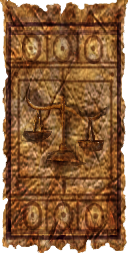Lore:House Mora
House Mora was a minor political house of Dunmer that was later absorbed into House Hlaalu in the First Era. One of their most esteemed families was the Ra'athim Clan, the royal family of Ebonheart and ancient retainers of the High Kingship of Morrowind.[1]
History[edit]
House Mora was an independent faction in Morrowind since the Conquest of Morrowind in the early First Era. A "rose-worn prince of garlands" affiliated with House Mora was a war hero at the time. According to Tribunal Temple mythology, the Warrior-Poet, Vivec traveled to House Mora's ancestor alcove to find the second monster that had escaped Muatra,[2] the Treasure Wood Sword. Vivec was approached by a bonewalker that told him that the monster will not leave their house and that a deal was made with Mephala. Vivec bypassed the bonewalker and met the King of Assassins, leader of the Morag Tong, who presented him with the Treasure Wood Sword. He explains that the Prince of House Mora was fond of Vivec and placed in the Corner of Mehrunes Dagon. He also claims that he set him to a fiery prayer for the wicked and that he stuffed birds into his mouth.[3]
At some point in time, House Mora was absorbed into House Hlaalu and it has become defunct ever since. The Ra'athim Clan became part of House Hlaalu and some of its members, such as Athyn Llethan had powerful positions in not just the Great House but in Morrowind by the late Third Era.[UOL 1] Since Barenziah's time, the house has had human ancestry.[1]
Notes[edit]
- The word, Mora, in most variations of the elven language, including the Dunmer language, translates into either Forest or Wood.[4] In some instances of Ayleidoon, the word can also mean Daedra.[5]
- In a forum post, developer Douglas Goodall once gave Nerevar's full and formal name as "Serjo Indoril Nerevar Mora", indicating a possible association with House Mora.[UOL 2]
References[edit]
- ^ a b The Real Barenziah, v 5 — Anonymous
- ^ 36 Lessons of Vivec, Sermon 18 — Vivec
- ^ 36 Lessons of Vivec, Sermon 22 — Vivec
- ^ Sul-Matuul's dialogue in Morrowind
- ^ Nilata Search Plan
Note: The following references are considered to be unofficial sources. They are included to round off this article and may not be authoritative or conclusive.
